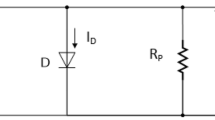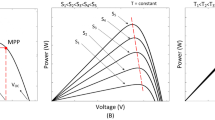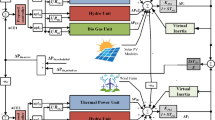Abstract
The power against voltage curve for PV power system during shadow condition contains number of local maximum power points (MPPs) and only one global. The classical maximum power point tracking (MPPT) algorithms are designed to follow the global MPP, but they stuck around local MPPs such as fuzzy logic controller (FLC). Therefore, A global MPPT based on teaching–learning-based optimization (TLBO) algorithm has been presented in this paper. The performance of PV system under abnormal conditions such as partial shading has been improved. TLBO algorithm is simple computational steps and faster convergence to optimal solution. A comprehensive assessment of TLBO-based tracker is carried out against FLC and particle swarm optimization (PSO) techniques for same conditions. Six different partial shading patterns have been employed to investigate TLBO performance using MATLAB/Simulink. The parameters of comparison include the tracking speed and overall tracking efficiency. The results confirm that TLBO-based tracker exactly convergence to global MPP under different studied cases. TLBO has best performance compared to the other studied techniques. The tracking speed is increased using TLBO-based tracker; the average tracking time of global MPP is reduced by more than 23.8 % compared with PSO in all studied different partial shading patterns.














Similar content being viewed by others
References
Bader Alajmi N, Khaled Ahmed H (2013) A maximum power point tracking technique for partially shaded photovoltaic systems in microgrids. IEEE Trans Ind Electron 60(4):3195–1596
Eltamaly AM (2010) Modeling of fuzzy logic controller for photovoltaic maximum power point tracker. In: Solar future 2010 conf. proc., Istanbul, Turkey, pp 4–9
Ahmed J, Salam Z (2014) A maximum power point tracking (MPPT) for PV system using cuckoo search with partial shading capability. Appl Ener 119:118–130
Liu Y et al (2012) A particle swarm optimization based maximum power point tracking algorithm for PV systems operating under partially shaded conditions. IEEE Trans Energy Convers 27(4):1027–1035
Sarvi M, Ahmadi S, Abdi S (2015) A PSO-based maximum power point tracking for photovoltaic systems under environmental and partially shaded conditions. Prog Photovolt Res Appl 23:201–214
Ma J et al (2013) Low-cost global MPPT scheme for photovoltaic systems under partially shaded conditions. In: IEEE international symposium on circuits and systems (ISCAS), pp 245–248
Tey KS, Mekhilef S, Yang H, Chuang M (2014) A differential evolution based MPPT method for photovoltaic modules under partial shading conditions. Int J Photoener 2014:1–10
Daraban S, Petreus D, Morel C (2013) A novel global MPPT based on genetic algorithms for photovoltaic systems under the influence of partial shading. In: IECON 2013-39\(^{\rm th}\) annual conference of the IEEE, pp 1490–1495
Phimmasone V, Kondo Y, Kamejima T, Miyatake M (2010) Evaluation of extracted energy from PV with PSO-based MPPT against various types of solar irradiation changes. In: IEEE international conference on electrical machines and systems, Korea, pp 487–492
Jiang L, Maskell D, Patra J (2013) A novel ant colony optimization-based maximum power point tracking for photovoltaic systems under partially shaded conditions. Energy Build 58:227–236
Ishaque K, Salam Z, Amjad M, Mekhilef S (2012) An improved particle swarm optimization (PSO)-based MPPT for PV with reduced steady-state oscillation. IEEE Trans Power Electron 27(8):3627–3638
Sundareswaran K, Peddapati S, Palani S (2014) MPPT of PV systems under partial shaded conditions through a colony of flashing fireflies. IEEE Trans Energy Convers 29(2):463–472
Sundareswaran K, kumar V, Palani S (2015) Application of a combined particle swarm optimization and perturb and observe method for MPPT in PV systems under partial shading conditions. Renew Energy 75:308–317
Kulaksız AA, Akkaya R (2012) A genetic algorithm optimized ann-based MPPT algorithm for a stand-alone PV system with induction motor drive. Solar Energy 86(9):2366–2375
Paraskevadaki EV, Papathanassiou SA (2011) Evaluation of MPP voltage and power of mc-Si PV modules in partial shading conditions. IEEE Trans Energy Convers 26(3):923–932
Tajuddin MFN, Arif MS, Ayob SM, Salam Z (2015) Perturbative methods for maximum power point tracking (MPPT) of photovoltaic (PV) systems: a review. Int J Energy Res 39(12):1153–1178
Besheer AH, Adly M (2012) Ant colony system based PI maximum power point tracking for stand-alone photovoltaic system. In: 2012 IEEE international conference on industrial technology (ICIT), pp 693–698
Lei M, Yaojie S, Yandan L, Zhifeng B, Liquin T, Jieqiong S (2011) A high performance MPPT control method. Int Conf Mater Renew Energy Environ (ICMREE) 1:195–199
Kazmi S, Goto H, Ichinokura O, Guo H (2009) An improved and very efficient MPPT controller for PV systems subjected to rapidly varying atmospheric conditions and partial shading. In: Power engineering conference (AUPEC 2009), pp 1–6
Kobayashi K, Takano I, Sawada Y (2006) A study of a two stage maximum power point tracking control of a photovoltaic system under partially shaded insolation condition. Solar Energy Mater Solar cells 90:2975–2988
Sundareswaran K et al (2015) Enhanced energy output from a PV system under partial shaded conditions through artificial bee colony. IEEE Trans Sustain Energy 6(1):198–209
Chen K, Tian S, Cheng Y, Bai L (2014) An improved MPPT controller for photovoltaic system under partial shading condition. IEEE Trans Sustain Energy 5(3):978–985
Rezk H, Eltamaly AM (2015) A comprehensive comparison of different MPPT techniques for photovoltaic systems. Solar Energy 112:1–11
Boutasseta N (2012) PSO-PI based control of photovoltaic arrays. Int J Comput Appl 48(17):36–40
Mirhassaniet SM et al (2015) An improved particle swarm optimization based maximum power pointtracking strategy with variable sampling time. Electr Power Energy Syst 64:761–770
Ishaque K, Salam Z (2013) A deterministic particle swarm optimization maximum power point tracker for photovoltaic system under partial shading condition. IEEE Trans Ind Electron 60(8):3195–3205
Gounden NA, Sabitha Peter A, Nallandula H, Krithiga S (2009) Fuzzy logic controller with MPPT using line-commutated inverter for three-phase grid-connected photovoltaic systems. Renew Energy J 34:909–915
Ben Salah C, Chaabenea M, Ben Ammara M (2008) Multi-criteria fuzzy algorithm for energy management of a domestic photovoltaic panel. Renew Energy 33:993–1001
Karlis AD, Kottas TL, Boutalisb YS (2007) A novel maximum power point tracking method for PV systems using fuzzy cognitive networks. Electr Power Syst Res 3–4:315–327
Khaehintung N, Wiangtong T, Sirisuk P (2006) FPGA implementation of MPPT using variable step-size P&O algorithm for PV applications. In: International symposium on digital object identifier, ISCIT, pp 212–215
Rao R, Patel V (2013) an improved teaching learning based optimization algorithm for solving unconstrained optimization problems. Scientia Iranica 20(3):710–720
Rao R, Savsani V, Vakharia D (2011) Teaching-learning-based optimization: a novel method for constrained mechanical design optimization problems. Comput Aided Des 2011(43):303–315
Pawar P, Rao R (2013) Parameter optimization of machining processes using teaching–learning-based optimization algorithm. Int J Adv Manuf Technol 67(5):995–1006
Cerpinsek M, Liu S, Mernik L (2012) A note on teaching learning based optimization algorithm. Inf Sci 212:79–93
LA361K51S-multi-crystalline photovoltaic module datasheet
Author information
Authors and Affiliations
Corresponding author
Rights and permissions
About this article
Cite this article
Rezk, H., Fathy, A. Simulation of global MPPT based on teaching–learning-based optimization technique for partially shaded PV system. Electr Eng 99, 847–859 (2017). https://doi.org/10.1007/s00202-016-0449-3
Received:
Accepted:
Published:
Issue Date:
DOI: https://doi.org/10.1007/s00202-016-0449-3




